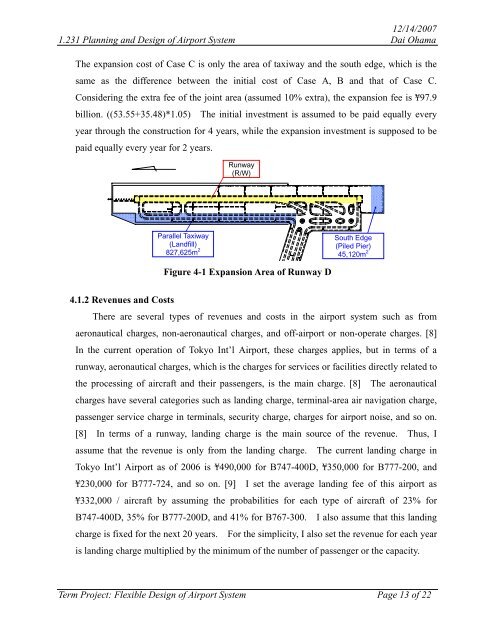Flexible Design of Airport System Using Real Options Analysis - MIT
Flexible Design of Airport System Using Real Options Analysis - MIT
Flexible Design of Airport System Using Real Options Analysis - MIT
Create successful ePaper yourself
Turn your PDF publications into a flip-book with our unique Google optimized e-Paper software.
12/14/2007<br />
1.231 Planning and <strong>Design</strong> <strong>of</strong> <strong>Airport</strong> <strong>System</strong> Dai Ohama<br />
The expansion cost <strong>of</strong> Case C is only the area <strong>of</strong> taxiway and the south edge, which is the<br />
same as the difference between the initial cost <strong>of</strong> Case A, B and that <strong>of</strong> Case C.<br />
Considering the extra fee <strong>of</strong> the joint area (assumed 10% extra), the expansion fee is ¥97.9<br />
billion. ((53.55+35.48)*1.05) The initial investment is assumed to be paid equally every<br />
year through the construction for 4 years, while the expansion investment is supposed to be<br />
paid equally every year for 2 years.<br />
Runway<br />
(R/W)<br />
Parallel Taxiway<br />
South Edge<br />
(Landfill)<br />
(Piled Pier)<br />
827,625m 2 45,120m 2<br />
Figure 4-1 Expansion Area <strong>of</strong> Runway D<br />
4.1.2 Revenues and Costs<br />
There are several types <strong>of</strong> revenues and costs in the airport system such as from<br />
aeronautical charges, non-aeronautical charges, and <strong>of</strong>f-airport or non-operate charges. [8]<br />
In the current operation <strong>of</strong> Tokyo Int’l <strong>Airport</strong>, these charges applies, but in terms <strong>of</strong> a<br />
runway, aeronautical charges, which is the charges for services or facilities directly related to<br />
the processing <strong>of</strong> aircraft and their passengers, is the main charge. [8] The aeronautical<br />
charges have several categories such as landing charge, terminal-area air navigation charge,<br />
passenger service charge in terminals, security charge, charges for airport noise, and so on.<br />
[8] In terms <strong>of</strong> a runway, landing charge is the main source <strong>of</strong> the revenue. Thus, I<br />
assume that the revenue is only from the landing charge. The current landing charge in<br />
Tokyo Int’l <strong>Airport</strong> as <strong>of</strong> 2006 is ¥490,000 for B747-400D, ¥350,000 for B777-200, and<br />
¥230,000 for B777-724, and so on. [9] I set the average landing fee <strong>of</strong> this airport as<br />
¥332,000 / aircraft by assuming the probabilities for each type <strong>of</strong> aircraft <strong>of</strong> 23% for<br />
B747-400D, 35% for B777-200D, and 41% for B767-300. I also assume that this landing<br />
charge is fixed for the next 20 years. For the simplicity, I also set the revenue for each year<br />
is landing charge multiplied by the minimum <strong>of</strong> the number <strong>of</strong> passenger or the capacity.<br />
Term Project: <strong>Flexible</strong> <strong>Design</strong> <strong>of</strong> <strong>Airport</strong> <strong>System</strong> Page 13 <strong>of</strong> 22

















